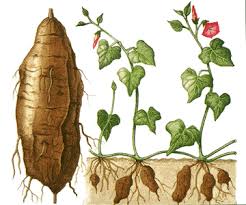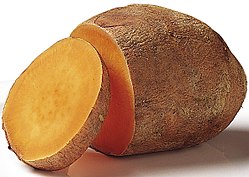
When was the last time you had YAMS for Thanksgiving? The answer to that question - for most people here in the U.S. - is NEVER! Canned 'yams' or fresh 'yams' are usually not found in this country unless you go to an African or Caribbean grocery store. Yams are very large tubers of tropical vines in the Dioscorea genus. The species include alata, rotunda, cayenensis, opposita, and many others. Rotunda and cayenensis are the most important of the cultivated yams and there are over 200 cutivated varieties of these species
 . Yams can grow to 7 feet long and are much sweeter than the sweet potato normally seen in our grocery stores. Yams have a brown or black skin and a purple, red or off-white flesh, based on the species, instead of the orange coloration of sweet potatoes. (In the picture above, the yam is the brown colored tuber on the far left.) Discorea, known in different regions in the world as African yam, Chinese Yam, Cinnamon Vine and other names, must be cooked in order to eat it. It contains compounds that make it dangerous to eat raw and exposure to the raw juices can cause skin irritations. To make the tuber palatable, it must be pounded, leached and then boiled to remove the toxins.
. Yams can grow to 7 feet long and are much sweeter than the sweet potato normally seen in our grocery stores. Yams have a brown or black skin and a purple, red or off-white flesh, based on the species, instead of the orange coloration of sweet potatoes. (In the picture above, the yam is the brown colored tuber on the far left.) Discorea, known in different regions in the world as African yam, Chinese Yam, Cinnamon Vine and other names, must be cooked in order to eat it. It contains compounds that make it dangerous to eat raw and exposure to the raw juices can cause skin irritations. To make the tuber palatable, it must be pounded, leached and then boiled to remove the toxins.  Yams are a staple in African countries because of its high sugar content and its ability to be stored for months with no refrigeration. In many African countries the yam is revered because of its abundance and how easy it is to grow. The yam vine can be grown in this country but is considered invasive and, in some parts of the country, are as bad as the kudzu vine! Most yam species need at least a 10 month growing cycle and the African yams need a 12 month cycle to produce the huge tubers. Yams are becoming known in some of the southern regions of the country but they will probably never replace the wonderful sweet potato!
Yams are a staple in African countries because of its high sugar content and its ability to be stored for months with no refrigeration. In many African countries the yam is revered because of its abundance and how easy it is to grow. The yam vine can be grown in this country but is considered invasive and, in some parts of the country, are as bad as the kudzu vine! Most yam species need at least a 10 month growing cycle and the African yams need a 12 month cycle to produce the huge tubers. Yams are becoming known in some of the southern regions of the country but they will probably never replace the wonderful sweet potato!The sweet potato, with its lovely orange skin and great taste in everything from pies to fries, is not even a potato!! The sweet potato is also the tuber of a vine - the sweet potato vine - that is a member of the morning glory family!!! Yes, the sweet potato is actually Ipomoea batatas,
 with its beautiful flower and long vines that are used today as ornamentals in your garden (they come in the dark purple and line green colors!). There are several species in the Ipomoea genus but only the batatas species is used as a crop plant. The sweet potato vine is actually a perennial but cannot stand the cold weather and will die back with the first frost. The plants need an average daily temperature of 74F, abundant water, and bright sunshine to grow well. North Carolina is the largest grower of sweet potatoes in the United States, with Mississippi right behind it.
with its beautiful flower and long vines that are used today as ornamentals in your garden (they come in the dark purple and line green colors!). There are several species in the Ipomoea genus but only the batatas species is used as a crop plant. The sweet potato vine is actually a perennial but cannot stand the cold weather and will die back with the first frost. The plants need an average daily temperature of 74F, abundant water, and bright sunshine to grow well. North Carolina is the largest grower of sweet potatoes in the United States, with Mississippi right behind it. Benton, Kentucky celebrates the sweet potato with its Tater Day Festival on the first Monday in April and other cities and towns across the U.S. celebrate the sweet tater with their own festivals during the year. When people in the U.S. began to grow sweet taters, they grew two different types, hard and soft. To distinguish between the two, the softer, brighter colored tuber was called a 'yam' and the harder lighter colored tuber was called a sweet potato.
Benton, Kentucky celebrates the sweet potato with its Tater Day Festival on the first Monday in April and other cities and towns across the U.S. celebrate the sweet tater with their own festivals during the year. When people in the U.S. began to grow sweet taters, they grew two different types, hard and soft. To distinguish between the two, the softer, brighter colored tuber was called a 'yam' and the harder lighter colored tuber was called a sweet potato. If you look on the containers or boxes that you see in the grocery stores - you should be able to see the correct name of the tuber (sweet potato) somewhere on the label; the USDA requires the correct name of 'sweet potato' somewhere on that label. These great plants are originally from South America and don't have a lot of natural enemies so they don't need a lot of pesticides to prosper. It can take from 2 - 10 months for the tubers to mature depending on the cultivar that you are growing. You should also know that in 1992, the Center for Science in the Public Interest ranked the sweet potato Number 1 in nutritional value when compared to all other vegetables! It ranks much higher than the potato for overall nutrition!!! So, not only does it taste good - it is VERY good for you.
If you look on the containers or boxes that you see in the grocery stores - you should be able to see the correct name of the tuber (sweet potato) somewhere on the label; the USDA requires the correct name of 'sweet potato' somewhere on that label. These great plants are originally from South America and don't have a lot of natural enemies so they don't need a lot of pesticides to prosper. It can take from 2 - 10 months for the tubers to mature depending on the cultivar that you are growing. You should also know that in 1992, the Center for Science in the Public Interest ranked the sweet potato Number 1 in nutritional value when compared to all other vegetables! It ranks much higher than the potato for overall nutrition!!! So, not only does it taste good - it is VERY good for you. 
When we were in South Carolina at the beginning of October, the farmers were selling their sweet potatoes on the sides of the roads (they harvest their sweet potato crop in October!) and we were able to buy HUGE bags of sweet taters for $6.00 a bag!!!! Needless to say, I bought several bags and distributed them to friends and family when I got home! We have been experimenting with dishes and have found that deep dish sweet potato pie (my hubby's mother's recipe - that HE makes), sweet potato fries, mashed sweet potatoes, sweet potato cake and on and on and on.... tastes MUCH better with fresh sweet potatoes! So, the next time you are in the grocery store - pass right by the canned sweet potatoes and go for the fresh tubers to make your sweet potato dish for Thanksgiving! It will taste better and is easy to make (just peel, boil and use) and the family will rave over your sweet potatoes!!! Oh, and also, remember that you are buying sweet potatoes - not yams!



No comments:
Post a Comment